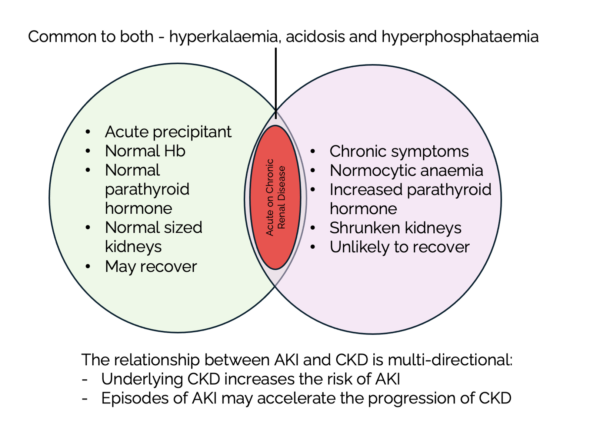- 📖 Geeky Medics OSCE Book
- ⚡ Geeky Medics Bundles
- ✨ 1300+ OSCE Stations
- ✅ OSCE Checklist PDF Booklet
- 🧠 UKMLA AKT Question Bank
- 💊 PSA Question Bank
- 💉 Clinical Skills App
- 🗂️ Flashcard Collections | OSCE, Medicine, Surgery, Anatomy
- 💬 SCA Cases for MRCGP
To be the first to know about our latest videos subscribe to our YouTube channel 🙌
Acute kidney injury (AKI)
An acute kidney injury (AKI) is caused by a rapid deterioration in kidney function.
The pathophysiology of AKI is separated into three main causes:
- Pre-renal: decreased blood supply resulting in decreased GFR
- Renal: damage to the nephron impairing the reabsorption capacity
- Post-renal: increased hydrostatic pressure resulting in reduced GFR
AKI is clinically detected when a patient presents with oliguria or anuria; often in the context of hospital admission or risk factors for AKI (e.g. underlying chronic disease, history of AKI, use of nephrotoxic drugs).
The management of AKI depends on the underlying cause. All patients should have their existing medications reviewed with removal of nephrotoxic medications.
AKI can be a significant cause of morbidity and mortality; however, prompt recognition and management can help to prevent progression and long-term damage.
Chronic kidney disease (CKD)
Chronic kidney disease (CKD) is defined as abnormal kidney function or structure present for greater than three months.
The most common causes of CKD are diabetes and vascular disease; CKD represents the end-stage for any cause of severe and/or long-standing kidney injury.
CKD is primarily asymptomatic, and symptoms usually only start developing when it is advanced.
Symptoms may include fatigue, nausea and vomiting, abnormal urine output and fluid overload. The general management of CKD involves a combination of lifestyle modifications, medications, and regular monitoring. Renal replacement therapy is an important aspect of the treatment of end-stage CKD.
Acute on Chronic Kidney Disease
‘Acute on chronic’ renal disease is characterised by the acute deterioration of renal function superimposed on pre-existing CKD. It should be suspected when a patient with known CKD experiences a sudden spike in serum creatinine above their established baseline.
Summary table
| Acute kidney injury | Chronic kidney disease | |
| Onset | Rapid decrease of renal function over hours to days | Gradual or progressive decrease of renal function over months to years |
| Clinical definitions | The kidney disease improving global outcomes (KDIGO) classification tool confirms an AKI with any of the following present:1
|
Abnormal kidney function or structure present for greater than three months, with subsequent implications for health.2 Further classified according to eGFR and proteinuria. |
| Aetiology |
|
|
| Clinical features |
|
Primarily asymptomatic; may have hypertension, haematuria and/or proteinuria |
| Diagnosis |
|
History indicating progressive derangement of creatinine and eGFR |
| Haemoglobin | Normal (rarely low, unless in the case of bleeding) | Low; chronic normocytic anaemia is common due to erythropoietin deficiency |
| Calcium and parathyroid hormone |
|
|
| Reversible? | Commonly reversible | Irreversible |
| Ultrasound appearance of kidneys | Typically normal; may show hydronephrosis in the case of obstruction | Asymmetrical kidneys, shrunken or enlarged kidneys |

References
- KDIGO. 2012 Kidney Disease: Improving Global Outcomes (KDIGO) Clinical Practice Guideline for Acute Kidney Injury (AKI). (2012). Available from: [LINK]
- NICE CKS. Chronic Kidney Disease – Definition. 2021. Available from: [LINK]




